Generals don’t really carry sidearms anymore. At least American generals don’t. Not even Retired Marine General James Mattis, as far as I can tell. Oh, I’m sure he occasionally strapped on an M9A1, but it doesn’t seem to have been an everyday thing. Modern war requires generals to exercise command some distance from the sharp end.
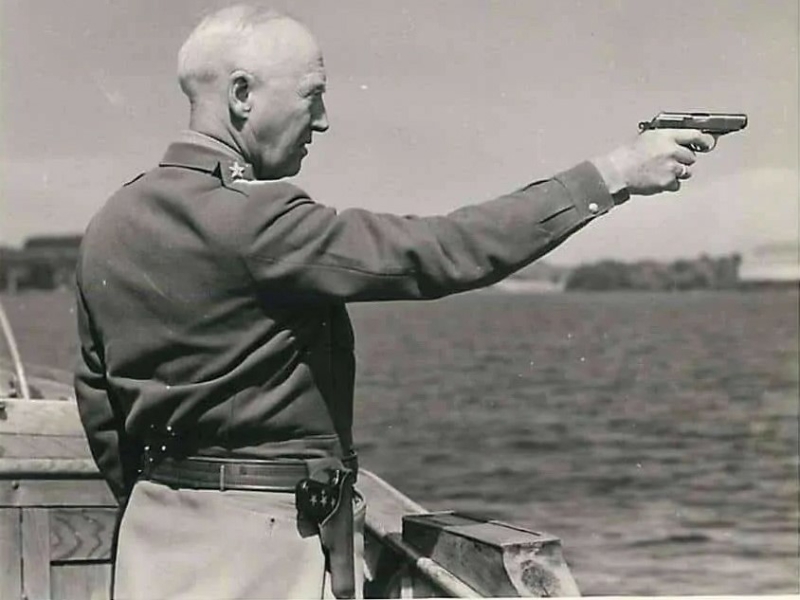
But that wasn’t always the case. American generals regularly carried sidearms before modern communications changed the game. Generals regularly faced enemy fire as late as World War II, prompting many to carry pistols, or even rifles on occasion. So, let’s look at what some American generals carried on battlefields from New York to the Great Plains, and overseas.
This is not meant to be an exhaustive list. For instance, General Andrew Jackson most assuredly carried at least one pistol during his many wars. But I was unable to find details about what those pistols were. Much more attention is given to his dueling pistols. Same for many others I researched. But nine American generals stood out. So, here are nine prominent examples of armed American generals.
George Washington
George Washington was the United States’ first, and possibly greatest, general officer. The Second Continental Congress commissioned Washington to command the colonial militias ringing British-held Boston in 1775. Washington saw front-line service from that point until the final peace settlement in 1783.

Washington’s proximity to the battle lines is illustrated by a 1777 incident in which he and Count Casimir Pulaski were scouting before the Battle of Brandywine Creek. Captain Patrick Ferguson, a British sharpshooter caught them dead to rights. Ferguson demanded they dismount and surrender, but Washington and Pulaski wheeled their horses and fled.
Captain Ferguson’s sense of honor was the only thing that saved Washington that day. Ferguson’s report stated that “As I was with the distance, at which in the quickest firing, I could have lodged a half dozen balls in or about him before he was out of my reach, I had only to determine, but it was not pleasant to fire at the back of an unoffending individual who was acquitting himself coolly of his duty, and so I let him alone.” Ferguson later learned that he spared George Washington but maintained that he would have done the same had he known his target’s identity.
Washington’s Guns
Washington is known to have carried three flintlock pistols at various times. The first was a gift from British Major General Edward Braddock in 1755. The .71 caliber pistol featured handsome wood, brass fittings, and a brass barrel. Braddock’s initials, “E.B.,” are inscribed on the brass. We know Washington carried it until at least 1777. The pistol was made by English gunmaker William Gabbitas.
The other two sidearms were a matched set of .57 caliber saddle pistols. The Marquis de Lafayette presented them to Washington in 1778. He carried them throughout the Revolution and during the Whiskey Rebellion, in which he became the only US president to lead troops in action. Washington so treasured these pistols that he provided for their safekeeping in his will. The pistols were later presented to President Andrew Jackson, who gave them back to Lafayette when he visited the United States in 1824-25. They were made in France by gunmaker Jacob Walster and now reside at Pennsylvania’s Fort Ligonier Museum.

Ulysses S. Grant
U.S. Grant is probably Washington’s greatest challenger to the title of America’s best general. Alcohol abuse seemingly ended Grant’s military career in 1854, but he returned to the colors for the Civil War. Grant quickly showed his natural command talent. He was a master of tactical and operational warfare, and later proved the war’s shrewdest strategist.
Grant’s past made his superiors skeptical, and several tried to have him sacked. But Abraham Lincoln knew what he had. “I cannot spare this man,” Lincoln replied. “He fights.” Lincoln promoted Grant to General-in-Chief in 1864. His predecessors tried and failed to take Richmond for three years. Grant coordinated operations in the Eastern and Western Theaters, took the city, and ended the war in less than a year.
Alcoholism overshadowed Grant’s command brilliance for well over a century. But he is finally getting his due as the Civil War’s best general, and possibly the best we’ve ever had. Most historians consider him America’s first modern general, thanks to his understanding of logistics and efforts to destroy the Confederacy’s ability to wage war on every level.
Grant’s Civil War battlefield sidearm was the .36 caliber Model 1851 Colt Navy revolver. The 1851 Navy was a cap and ball design, meaning the cylinder must be loaded and charged from the front, using the lever mounted under the barrel. Percussion caps are then added to the cylinder’s rear. Like most other black powder Civil War weapons, they were difficult to reload quickly. But they were light years ahead of the American Revolution’s single-shot muzzle-loading pistols.

Robert E. Lee
Grant’s Confederate counterpart, General Robert E. Lee, is also counted among America’s greatest commanders. Lee was a master of operational warfare, always adept at maneuvering to hit his opponent where it hurt the most. He was perhaps the most audacious American general to ever take the field, rivaled only by Stonewall Jackson and George S. Patton, though Jackson never commanded so large a force as the Army of Northern Virginia.
Lee was at his best when he found his enemy’s flank, which advantage he never failed to exploit. Lee, however, failed to grasp the strategic realities of modern warfare, placing too much emphasis on the war’s Eastern Theater. Grant correctly identified Lee’s army as the Confederacy’s center of gravity, but he also understood that crippling the Southern economy directly affected his foe’s ability to fight. Lee seems to have lacked such insight. To be fair, however, the ramshackle Confederate economy gave him little to work with, and he had no real ability to strike at Northern infrastructure.
Lee’s chosen sidearm was also the Model 1851 Colt Navy in .36 caliber. Lee’s pistol briefly made the newspapers after he died in 1870. He didn’t carry it after the war, but it seems the general never unloaded it when he hung up his gray uniform. In fact, it’s believed that Lee last loaded the pistol in 1863, right at the height of the war, but never fired it. All six chambers discharged properly when the gun was fired after his death.
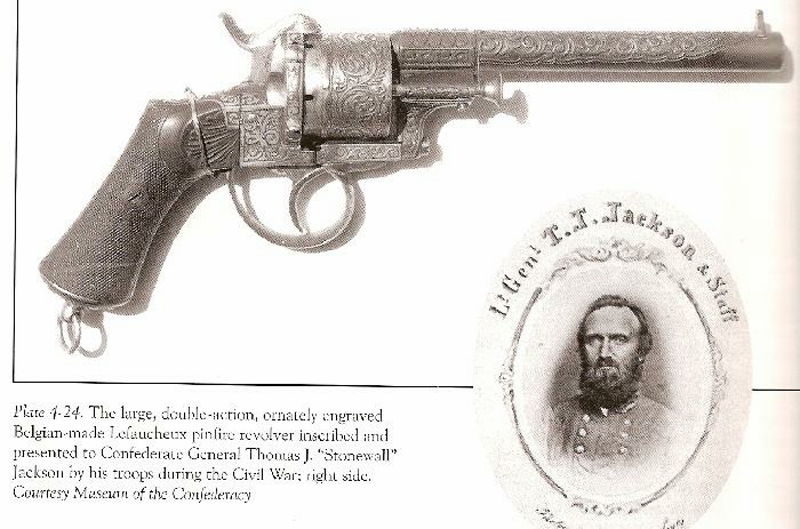
Stonewall Jackson
Lt. General Thomas J. “Stonewall” Jackson was Lee’s most talented subordinate commander. Jackson’s natural aggression matched Lee’s own, but he also proved himself capable of independent command. Professionals and historians alike still regard Jackson’s 1862 Shenandoah Valley Campaign as a masterpiece of operational-level warfare. It was Jackson’s corps who executed Lee’s daring flanking maneuver at the 1863 Battle of Chancellorsville, routing the numerically superior Army of the Potomac. But a pall fell on the triumph when Jackson was mistakenly shot by his own men while scouting Union positions later that night.
Jackson was a stern, unbending warrior who demanded nothing less from his men. His methods were often harsh, but they consistently yielded victorious results. Jackson himself was always near the front, personally rallying his men more than once. We know that he possessed two different sidearms that were given to him during the war. The first was a LeMat revolver gifted to him by General P.G.T Beauregard, who was inventor Jean Alexandre LeMat’s cousin and business partner. The LeMat was a .42 caliber muzzle-loading cap and ball design featuring a smooth bore shotgun type barrel along with a longer 6.75-inch rifled barrel. The shooter could switch between barrels by adjusting the hammer’s pivoting striker.
Jackson’s second pistol was apparently a Belgian copy of the French Lefaucheaux pinfire revolver. Pinfire guns fired a special cartridge with a cardboard body and brass base. The cartridge expanded when fired, creating an effective gas seal. The design facilitated the development of breech-loading firearms and more powerful small-caliber ammunition. They were double-action and typically chambered in 9mm or 12mm. Jackson’s was apparently a 9mm version. The barrel is inscribed “Presented to Major General Thomas J. Jackson by his Officers, near Camp Richmond.” The gun was held by the Museum of the Confederacy, which merged with the American Civil War Museum in 2013. That museum presumably still has Jackson’s revolver, but I was unable to find a quality photo. The one above is the best I can do.
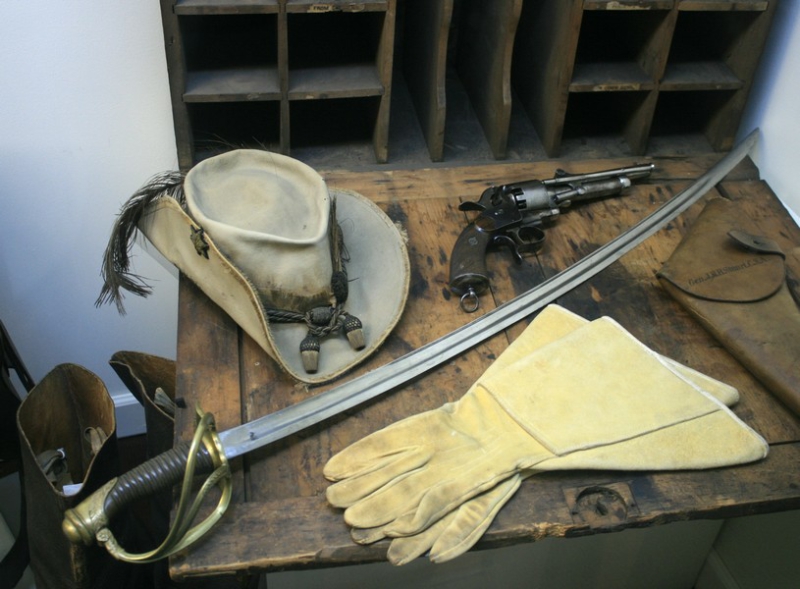
J.E.B. Stuart
James Ewell Brown “Jeb” Stuart was the Army of Northern Virginia’s superb cavalry commander. His Civil War exploits are legendary, and his sustained success in the saddle is only rivaled by Nathan Bedford Forrest and Philip Sheridan. Stuart considered himself a true cavalier, with exquisitely tailored uniforms and an ostrich-plumed hat.
One might mistake Stuart for a dandy were it not for his performance in the field. His command’s most famous exploit was riding around the entire Union Army during the 1862 Peninsula Campaign. That epic recon mission gave Robert E. Lee the intelligence he needed for a devastating flank attack on General George B. McClellan, forcing his entire army back from Richmond’s gates, and eventually back to Washington.
Stuart also ably commanded Jackson’s corps at Chancellorsville after Stonewall was mortally wounded. He was disappointed when Lee gave the corps to General Dick Ewell. But Lee considered Stuart too valuable as a cavalry commander. Stuart, however, was not perfect, as evidenced by his failures in the Gettysburg Campaign, though some blame must lie with Lee’s habit of issuing somewhat vague orders.
Stuart favored fine sabers and pistols, and he owned a LeMat revolver like Jackson’s. He also had an English Tranter revolver given to him by former Prussian officer Heros von Borcke. Von Borcke took leave from his Prussian post to serve in the Confederate Army, and he was Stuart’s chief of staff until he was badly wounded in June of 1863. Shortly thereafter, the Prussian presented the boxed Tranter to Stuart. The box’s inscription reads, “LT. GEN J.E.B. STUART C.S.A. CULPEPPER, VA JUNE 1863/ FROM HEROS VON BORCKE.”
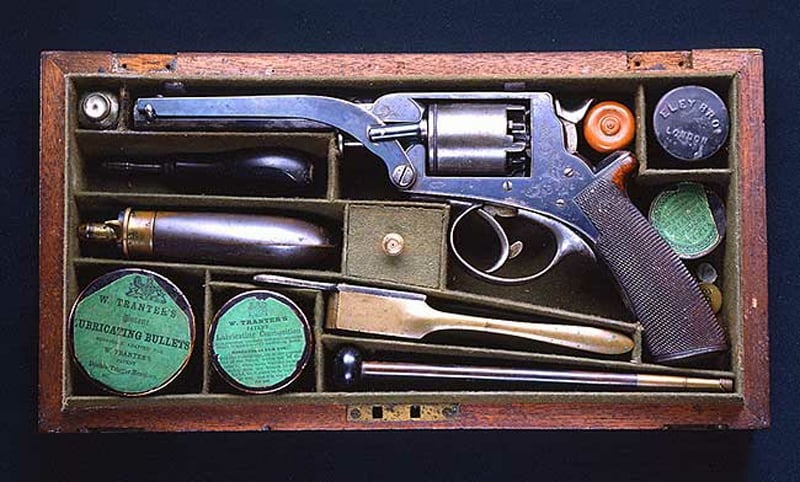
It seems von Borcke anticipated Stuart’s promotion to Lt. General following his handling of Jackson’s corps at Chancellorsville. The erstwhile promotion proved premature, as Stuart never attained rank beyond Major General. The Tranter revolver was a double-action cap and ball invented by William Tranter. Early models featured a dual trigger, one to rotate the cylinder and cock the gun, and one to fire the weapon. Later models, including Stuart’s, had only one trigger. The gun was available in various calibers. Stuart’s gun was a .44.
George Armstrong Custer
George Custer was a precocious cavalry commander who became a Brigadier General of Volunteers at the tender age of 23. He was a West Point graduate whose first battle as a general officer saw his Michigan Cavalry Brigade repulse J.E.B. Stuart on Gettysburg’s critical third day. Custer later proved himself in General Philip Sheridan’s 1864 Shenandoah Valley Campaign, and his division blocked the Army of Northern Virginia’s final retreat at Appomattox in 1865.
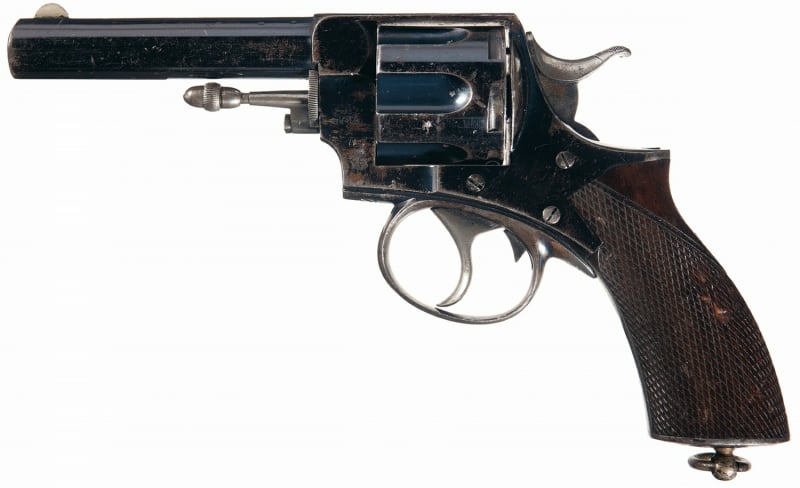
Custer received a Regular Army commission after the Civil War as a Lieutenant Colonel of Cavalry. Many wartime officers had to accept rank reduction to stay in the dramatically reduced postwar force. His most famous action, of course, was his command of the US 7th Cavalry Regiment at the 1876 Battle of the Little Bighorn. Custer’s command was destroyed by allied Plains tribes under Sitting Bull and Crazy Horse, and Custer himself was killed. Custer wasn’t actually a general in 1876, but he had held that rank, so I include him here.
Custer is believed to have carried a Webley Royal Irish Constabulary revolver at the Little Bighorn. The British Lord Berkeley Paget supposedly gave Custer two Webley RICs after an 1869 buffalo hunt. Custer reportedly gave one pistol to his brother, Tom, though no evidence of either gun remains. Some speculate that the Lord Paget story never happened and that Custer only owned one Webley RIC. One photograph exists in which the revolver seems to rest on a gun rack. That photo’s date would make Custer’s RIC a First Model chambered in .442. The RIC was double-action, and the military version had a 4-inch barrel.

Either way, George Custer’s gun was likely carried off as a war trophy after the battle. Indeed, the fact that all of Custer’s other guns are accounted for is strong evidence that he did indeed carry the RIC at the Little Bighorn. No .442 cartridges or cases have been found on the battlefield, but the close fighting may have prevented Custer from reloading, meaning the cases remained in the cylinder.
Dwight D. Eisenhower
Dwight Eisenhower rose from an obscure Brigadier General in 1941 to 5-star rank and command of all Allied forces in Europe by 1945. Army Chief of Staff, General George C. Marshall, had observed Eisenhower from afar and handpicked him for a fast track to high command. Marshall chose well, as Eisenhower proved the steady, level-headed commander the Allies needed to manage a multi-national force on a continental scale.
He also successfully wrangled mercurial officers like George S. Patton and Bernard Law Montgomery, who were vital to the war effort. Eisenhower’s most underappreciated task may have been protecting Patton after the infamous slapping incident in Sicily. Politicians and some officers called for Patton’s head, but Ike knew he needed Patton’s talents for the upcoming European Campaign.
Eisenhower was a shrewd and careful strategist as well. He understood the war’s global nature and, despite downplaying the Pacific’s unique complexities, consistently saw the big picture. Ike gave his subordinate commanders the freedom they needed, but he was decisive when circumstances demanded it.
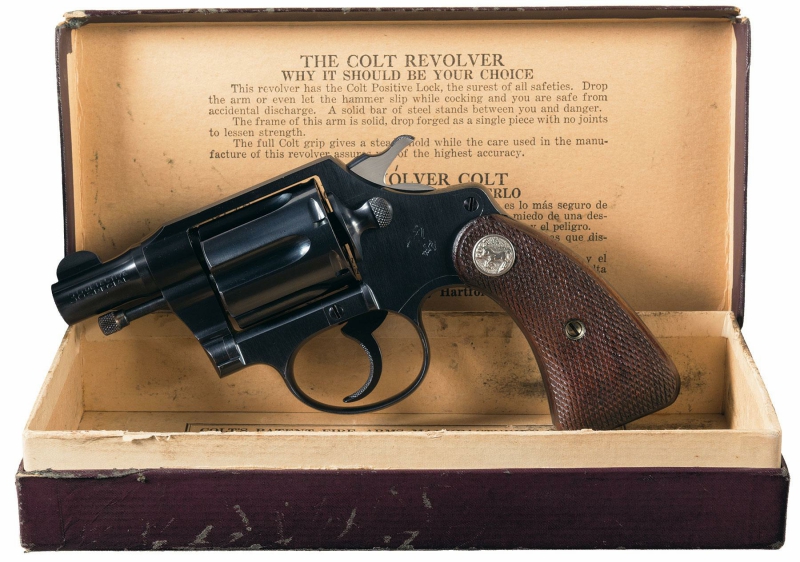
The Supreme Allied Commander in Europe didn’t directly command combat units, but he did carry a sidearm. Eisenhower liked guns and assassination was at least a possibility. So, Ike carried a Colt Detective Special revolver chambered in .38 Special. The Detective Special is a classic Colt firearm, debuting in 1927. Its 2-inch barrel is perfect for concealment, and it would have made a lightweight, low-profile sidearm for Europe’s top general. True to his low-key personality, Eisenhower returned the Colt to the Army upon his retirement. You have to wonder what happened to it.
George S. Patton, Jr.
George Patton is possibly America’s most famous general. And why not? He was successful, flamboyant, and controversial. The superb 1970 movie, Patton, probably didn’t hurt either. Patton was the premier Allied field commander in Europe, beginning with his Seventh Army’s Sicilian Campaign. The German command knew that and was certain that Patton would command the 1944 invasion of France. The Allies leveraged that certainty by building a fake army around him to distract their attention, divert their resources, and freeze their reserves. The deception succeeded so well that the German High Command believed Normandy was a diversion for more than a week.
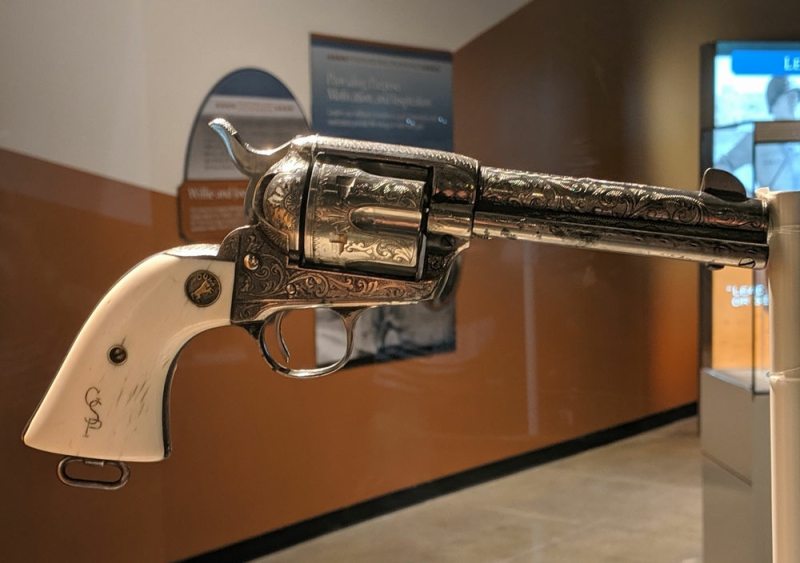
Patton got to France late, but he didn’t disappoint. His Third Army broke out of the Normandy beachhead and promptly performed an end run around the German left flank, forcing their retreat past Paris and into Belgium and Holland. Patton’s troops only slowed down when gasoline was diverted for Montgomery’s ill-fated September 1944 airborne operation into Holland.
George Patton lived big, and his sidearm choices reflected his personality. Patton was part of General John J. Pershing’s 1916 punitive expedition against the Mexican bandit Pancho Villa. He carried his personal M1873 Colt Single Action Army revolver, chambered in .45 Colt. He used it to take down two fugitives, including Villa’s top deputy, Captain Julio Cardenas, who Patton shot off his horse.
But Patton only had five rounds since he carried with the hammer down on an empty chamber. He reportedly emptied the cylinder three times. Had Lt. Patton’s men not been present, the rest of the gang would likely have killed him when he expended his ammo. Patton notched his Colt, took Cardenas’ spurs, and got himself a backup SAA as soon as possible.

Patton’s revolvers sported custom engraving, and his initials, “GSP,” were carved into the ivory grips. Patton gave the second Colt to an entertainer he admired, who spent his time performing for the troops. He replaced it in 1935 with a 3 1/2-inch barrel Smith & Wesson .357 Magnum, also with ivory grips. He called the Smith his “Killing Gun,” though there’s no evidence that he killed anyone with it. Patton usually only carried one revolver, reserving the two-gun look for special occasions. Patton’s revolver, gun belt, and other memorabilia reside at the General George Patton Museum at Fort Knox, Kentucky.
Patton also liked small .32 ACP and .380 ACP semi-auto pistols and often carried one or more on his person. One of those was a rebuilt Remington R51 that his family sent him in early 1944. Patton called them his “insurance guns,” and usually wore them in a quick-draw waistband holster inside his uniform shirt. But he sometimes wore them on his hip, as in this article’s top photo. These small pistols’ grips featured engraved general’s stars.
James Gavin
Major General James “Jumping Jim” Gavin commanded the US 82nd Airborne Division for 1944’s Operation Market Garden. Before that, Gavin led the 505th Parachute Infantry Regiment in Sicily and Italy and was the 82nd’s deputy commander in Normandy. Gavin jumped with his men, hitting the ground as they did. Generals tend to have their own choice of weapons, and Gavin was no different. He jumped with a standard M-1 Carbine, whose light compactness and .30 Carbine cartridge made it perfect for paratroopers.

Gavin swapped his Carbine for a full-sized M-1 Garand rifle once he hit the ground. He liked the Garand’s longer range and more powerful .30-06 cartridge. Gavin also packed a Colt M1911 pistol, making him one of the best-armed general officers in the European Theater of Operations. Gavin’s M-1 Carbine now lives at the US Army Airborne and Special Operations Museum at Fort Bragg, uh, I mean Fort Liberty, North Carolina.
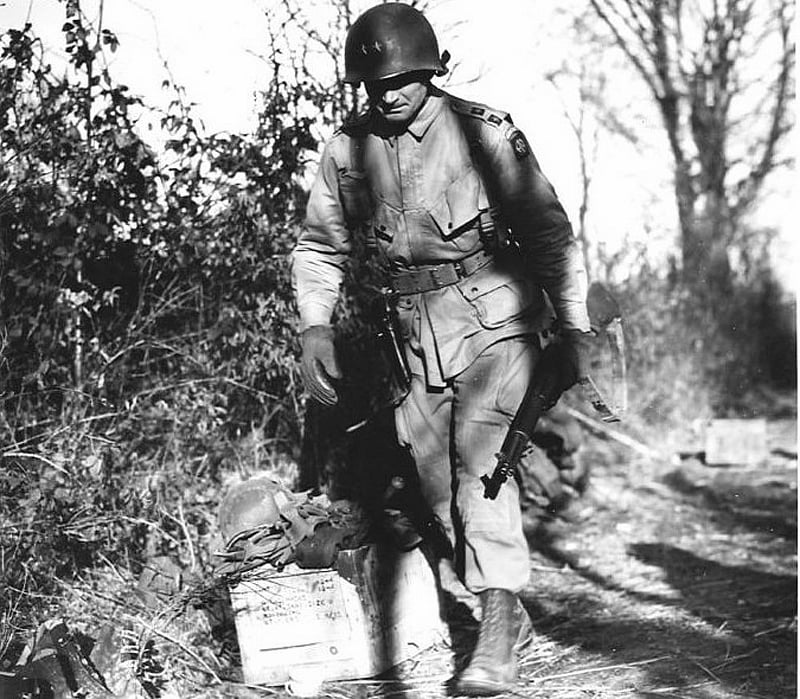
Armed Generals
This list is obviously incomplete. Generals have carried sidearms throughout history. These are merely some notable examples who happened to carry interesting weapons. I’ve tried to narrow it down to men who carried those weapons when they were generals. Custer is the only exception. I also excluded presentation guns, which many generals received after they retired. As noted, there’s not much reason for modern generals to arm themselves. But I admit to being a little disappointed at not finding evidence that Jim Mattis and Norman Schwarzkopf regularly packed heat. They just seem the type. Either way, generals usually have more leeway than other ranks, meaning they have often armed themselves a little differently, if not eccentrically. Sounds like a good reason to be a general.


